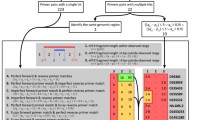Abstract
In order to understand evolutionary aspects of the highly polymorphicHLA-F microsatellite (heterozygosity>90%), several alleles of primates were characterized. 576 meioses from 35 CEPH families were investigated for regular transmission. Furthermore 364 healthy, non-related individuals belonging to four populations from distant ethnic groups were analysed to determine the applicability of this locus in population studies.
Sequencing revealed alternate (GAGGAA)n blocks spaced by (GAA)n repeats in all primates analysed. The mutation rate of this locus amounts to 1.5%. The mutational patterns follow approximately the one step mutation model. Differential analysis suggests that mutation rates depend on the repeat length. Paternal mutation rates exceed maternal ones. The presence of both allele classes in all human populations investigated indicates that this polymorphism predated raciation. Evidence is provided that the short alleles originated from the longer ones by deletion. Finally the differential analysis of each allele class corroborates the biological history of the studied populations as traced by other genetic markers.
Similar content being viewed by others
References
Bowcock A.M., Ruiz-Linares A., Tomfohrde J., Minch E., Kidd J.R. & Cavalli-Sforza L.L., 1994.High resolution of human evolutionary trees with polymorphic microsatellites. Nature 368: 455–457.
Campuzano V., Montermini L., Moltò M.D., Pianese L., Cossée M., Cavalcanti F., Rodious F. et al., 1996.Friedreich's ataxia: autossomal recesive disease caused by an intronic GAA triplet repeat expansion. Science 271:1423–1427.
Carvajal J.J., Pook M.A., dos Santos M., Doudney K., Hillermann R., Minogue S., Williamson R. et al, 1996.The Friedreich's ataxia gene encodes a novel phosphatidylinositol-4-phosphate 5-kinase. Nature Genet. 14:157–162.
Cavalli-Sforza L.L., Menozzi P. & Piazza A. (eds), 1994. The history and geography of human genes. Princeton University Press. Princeton, New Jersey.
Deka R., Jin L., Shriver M.D., Yu L.M., DeCroo S., Hundrieser J., Bunker C.H., et al., 1995.Populations genetics of dinucleotide (dC-dA)n (dG-dT)n polymorphisms in world populations. Am. J. Hum. Genet. 56:461–474.
Di Rienzo A., Peterson A.C., Garza J.C., Valdes A.M., Slatkin M. & Freimer N.B., 1994.Mutational process of simple-sequence repeat in human populations. Proc. Natl. Acad. Sci. USA 91: 3166–3170.
Applen C., Epplen J.T., Frank G., Miterski B., Santos E.J.M. & Schöls L. 1997.Differential stability of the (GAA) n tract in the Friedreich Ataxia (STM7) gene. Hum. Genet. (99:834–836).
Geraghty D.E., Wei X., Orr H.T. & Koller B.H., 1990.Human leukocyte antigen F (HLA-F) an expressed HLA gene composed of a class 1 coding sequence linked to a novel transcribed repetitive element. J. Exp. Med. 171:1–8.
Goldstein D.B., Linares A.R., Feldman M.W. & Cavalli-Sforza L.L., 1995.An evaluation of genetic distances for use with microsatellite loci. Genetics 139:463–471.
Jin H., Macaubas C., hallmayer J., Kimura A. & Mignot E., 1996.Mutation rates varies among alleles at a microsatellite locus: Phylogenetic evidence. Proc. Natl. Acad. Sci. USA 93:15285–15288
Jorde L.B., Bamshad M.J., Watkins W.S., Zenger R., Fraley A.E., Krakowiak P.A., Carpenter K.D., et al., 1995.Origins and affinities of modern humans: a comparison of mitochondrial and nuclear genetic data. Am. J. Hum. Genet. 57:523–538.
Lázaro C., Gaona A., Ainsworth P., Tenconi R., Vidaud D., Kruyer H., Ars E., et al (1996)Sex differences in mutational rate and mutational mechanism in the NF1 in neurofibromatosisi type 1 patients. Hum. Genet. 98:696–699.
Nei M. (ed), 1987. Molecular evolutionary genetics. Columbia University Press, New York.
Raha-Choudhury R., Tigue N.J. & Worwood M., 1994.Trinucleotide repeat microsatellite in the 5′ untranslated region of HLA-F. Hum. Mol. Genet. 3:2084.
Raha-Choudhury R., Bowen D.J. & Worwood M., 1996.A new highly polymorphic marker in the 5′ untranslated region of HLA-F shows strong allelic association with haemochromatosis. Hum. Genet. 97:228–231.
Slatkin M., 1995.A measure of population subdivision based on microsatellite allele frequencies. Genetics 139:457–162.
Slatkin M., 1996.Gene genealogies within allelic classes. Genetics 143:579–587.
Valdes A.M., Slatkin M. & Freimer N.B., 1993.Allele frequencies at microsatellite loci: the stepwise mutation model revisited. Genetics 133:737–749.
Vogel F. & Motulsky A.G. (eds), 1996. Human genetics: problems and approaches. Springer-Verlag, Heidelberg, Germany
Watkins W.S., Bamshad M. & Jorde L.B., 1995.Population genetics of trinucleotide repeat polymorphisms. Hum. Mol. Genet. 4:1485–1491.
Weber J.L. & Wong C., 1993.Mutation of human short tandem repeats. Hum. Mol. Genet. 2:1123–1128
Zhivotovisky L.A. & Feldman M.W., 1995.Microsatellite variability and genetic distances. Proc. Natl. Acad. Sci. USA 92:11549–11552.
Author information
Authors and Affiliations
Rights and permissions
About this article
Cite this article
Santos, E.J.M., Epplen, J.T., Epplen, C. et al. Microsatellite evolution in the 5′ UTR of theHLA-F gene. Hum. Evol. 13, 57–64 (1998). https://doi.org/10.1007/BF02439369
Received:
Accepted:
Issue Date:
DOI: https://doi.org/10.1007/BF02439369




